by
Kate Adams
Art and Disabilty in the time of Covid 19
I was surprised and excited when Outside In invited me to be their artist of the month. Outside In is a national charity that aims to provide a platform for artists who face significant barriers to the art world due to health, disability, social circumstances, or isolation.
I became involved with the organisation when I took a client, a Jamaican man who had started painting in immigration detention, to an artists’ support day. They provided him with a web site and helped him to write an artist’s statement. He was encouraged to enter a competition and was one of 80 artists whose art was exhibited in the Piano Nobile Gallery in London last year.
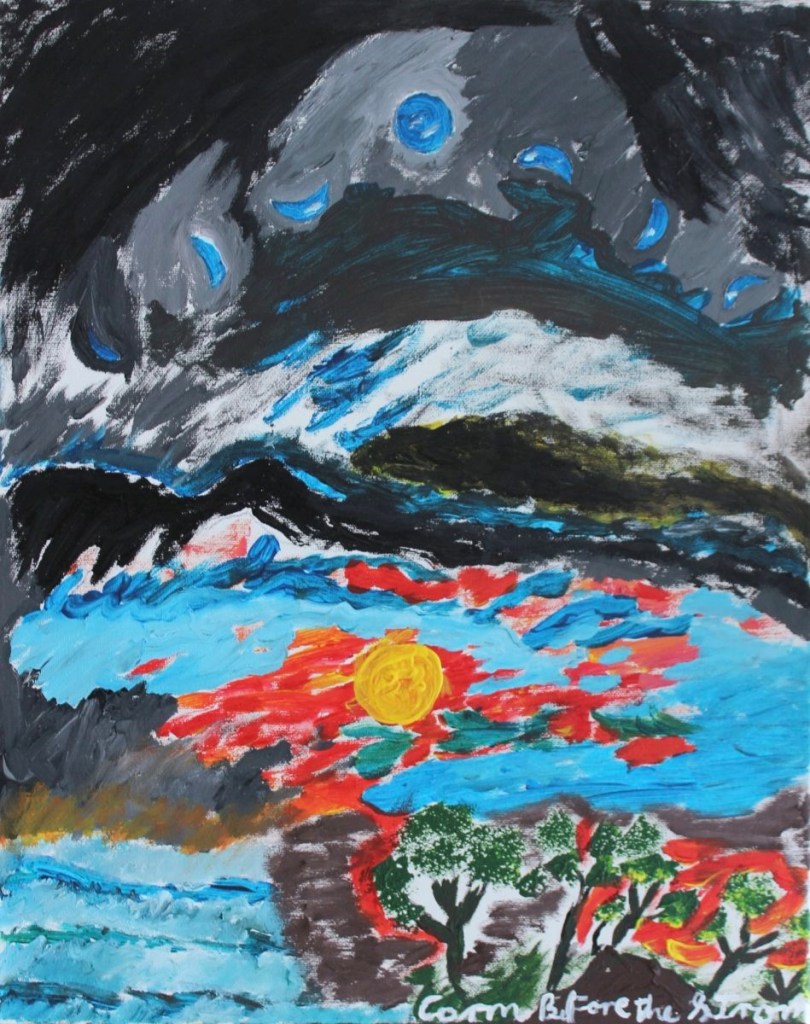
My work was also in the exhibition and I was offered support as an artist who has struggled with ME/Chronic Fatigue Syndrome for many years. I believe that art, and other opportunities to explore creative pursuits, are vital to our mental health in a capitalist society that values us for what we can produce rather than our potential as human beings. Artists stand outside the system and this way we make an important contribution to any critical process.
Outside In has given essential support for artists during the Pandemic through their regular newsletter, telephone, and email contact. Lockdown has been incredibly difficult for disabled people with reduced services increasing a sense of exclusion and isolation. Friends with mental health issues have told me of suicides during this period and Outside In is providing an important lifeline. I thank them for the brilliant work they do to change the art world and society.
Following is an interview I did with Outside In during my sojourn as Artist of the Month, which was finalised Monday 6th July 2020:

Artist of the Month interview with Outside In – Kate Adams
Meet our artist of the month, Kate Adams, who has been painting and drawing since she was very young, and who also writes poetry and short stories. She says , “Art has stayed with me as a life force, during my lowest moments, in the hardest times. I hope my paintings will encourage others to find the artist in themselves… “
Why and when did you start making art?
I cannot remember a time when I was not drawing or using colour. My father was the curator of the Bristol Art Gallery and I grew up in a house full of art books and paintings. There were reproductions of works by Cezanne, Manet and Van Gogh on our walls and also two original pastels by George Clausen which were given to my father in thanks for his long service to the Gallery. My father encouraged and nurtured my interest in art. As a child from a working- class, single parent family he had struggled to access an education. Art was everything to him and through this shared passion we formed a close bond. He was my strongest influence and my best teacher but I am aware that throughout my artistic endeavours I tried to please him. This is something that in later life I am still trying to address.
I went to art school and found this a difficult place to learn because there was a lot of institutional sexism. When I look back, I see many positive aspects to this time such as unlimited access to the life model in our final year. I have a happy memory of the long view over a park and houses from the high studio window from which my first landscape paintings emerged.
As well as art my family were concerned with social justice; my Jewish mother was initially a social worker and my parents adopted my sister who was of mixed heritage, Jamaican and Caucasian. Much later after my mother died, my father and I were part of a visitors’ group supporting migrants detained in Kent. I have been involved in anti- racist and disabled rights campaigns and supported the work of migrant artists. In 2018 I co-curated Our Lives, an exhibition of art by foreign national prisoners held in the Fish Slab Gallery, Whitstable. Prior to that a collection of my poems The Cheering Rain, inspired by my work with detained migrants, was published by Conversation Press.

I have given a lot of myself up to fighting inequality and helping the most dispossessed people. Alongside this work for justice I have always been creative and I have been sometimes been torn between these different paths. Conversely, they can also energise each other. Painting was there from the beginning. It is my life force and the core of my being. I am now making it a priority.
Where do you work?
I have a room in my house that is my studio. I also work outside, using pastel drawings and painted sketches of landscapes as a basis for more considered works. My ideas, observations and plans are collected in small sketchbooks and in my head where paintings arrive but are not always realised.

Do you follow a set process or does it vary?
I am very chaotic. I start with a visual memory or an experience using drawings and sometimes postcards for reference. I begin with charcoal, cover the surface with paint, using rags and a palette knife more often than a brush. Frequently I become dissatisfied and I may turn the picture upside down or paint over it. My studio is full of unresolved and uncompleted paintings. This is an exhausting process and I wish it could be otherwise. However, I know that all my perceived mistakes are steps towards finding a conclusion; painting like life is a struggle and if I am patient, I will find a way.
How would you describe your work?
Primarily I am a landscape painter. I am interested in colour and mark making as a means of expressing emotion. The artist John Constable said “Painting is but another word for feeling” and I believe this relates to my work. I also write stories and poems. The two art forms are linked for me and I have sometimes used text when exhibiting my work.
What have you been working on during lockdown?
Lockdown presented an opportunity for me to produce more creatively. My paid job is visiting foreign national prisoners faced with deportation; under lockdown the prisons closed for visits and I suddenly found I had more time. I decided to document my lockdown experiences through art, beginning with a poem: Now is the Time, which recognised the potential of this moment, however distressing and isolating . A subsequent idea was to make paintings of landscapes that were no longer accessible to me due to the ban on all but essential travel.
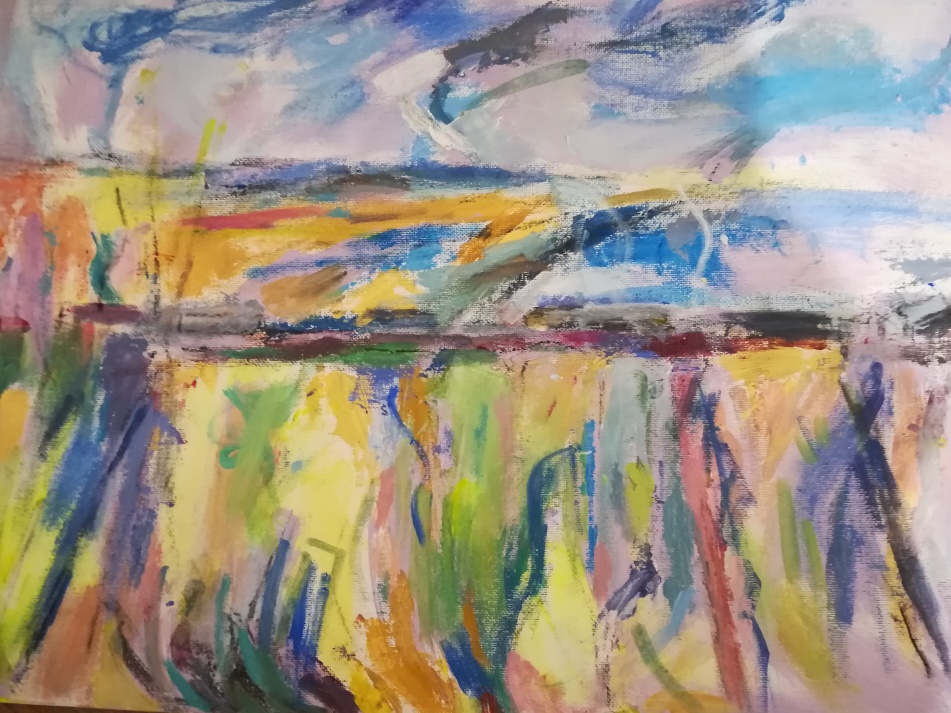
Romney Marsh was one such painting. When I was working on it in April, I imagined the fluctuations of spring weather and the feeling of sky and rain. My work was disrupted by a relapse of ME, a chronic and disabling condition I have lived with for many years. I was told by a GP that this was a post viral reaction to the Covid -19 virus which I had probably contracted in March after visiting a prison. I cannot be sure it was Covid because I was never tested. The virus itself was mild but persistent and recurrent. The relapse which followed at the end of April devastated my physical and mental functioning and for several weeks I was only surviving, unable to think, write or paint.
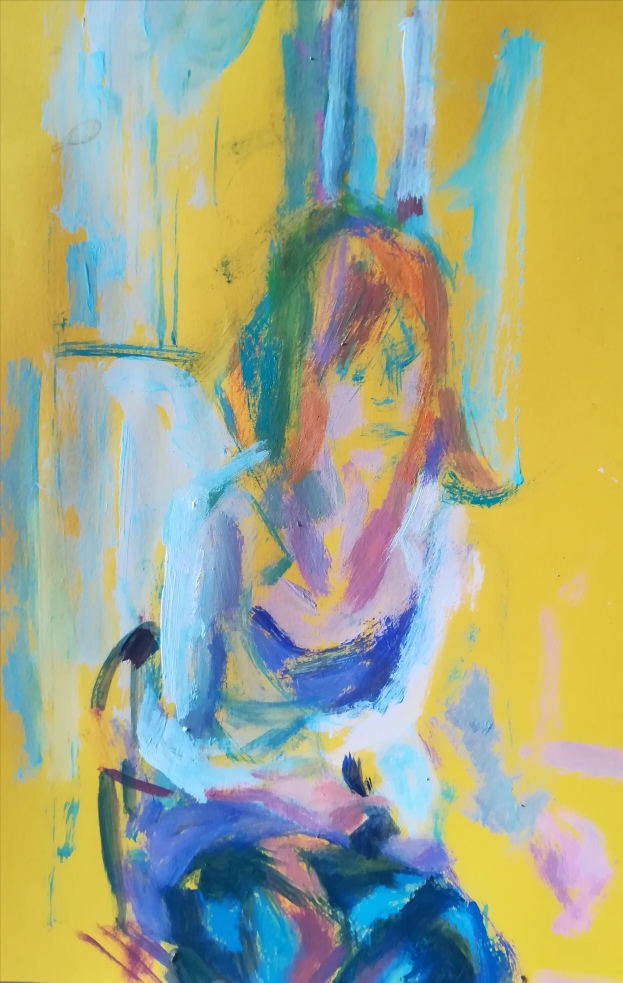
In Self Portrait-ill painted at the end of May I tried to objectively represent myself as a woman diminished by illness but there is an energy which contradicts this in the contrasting use of yellow and violet and the gestural marks which describe the form.
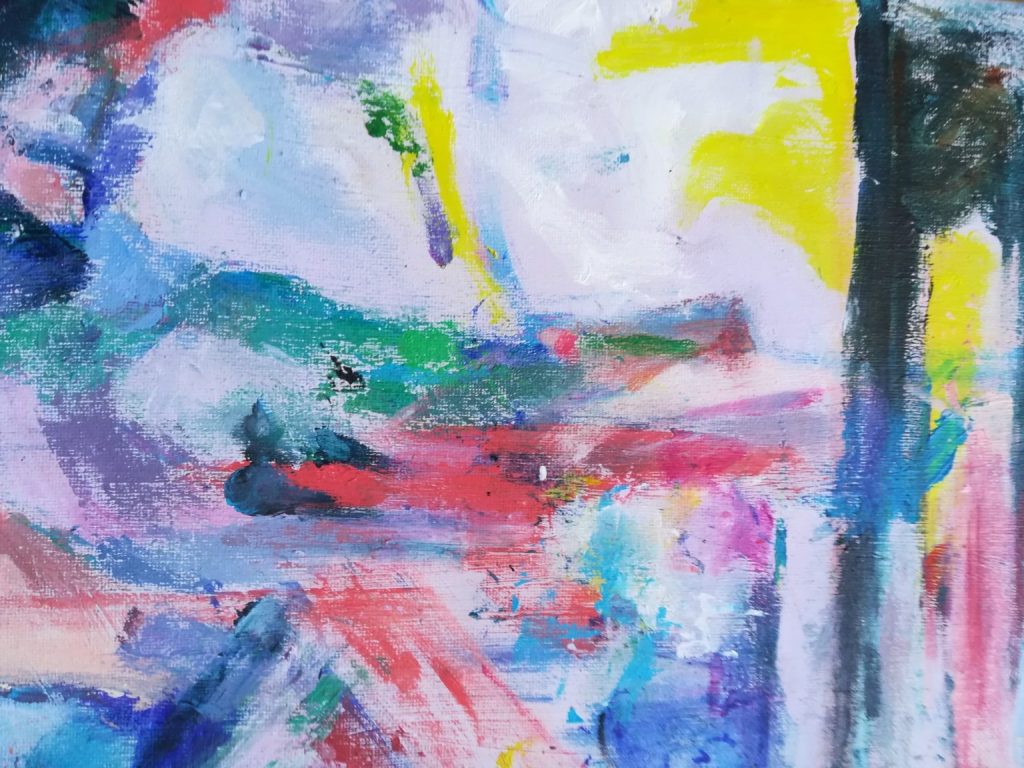
Cornwall, painted in the first warm days in June is a recorded memory of a holiday. I used red household paint to denote the heat and power my body lacked and yellow for the hope in sunshine.

I painted The Slopes a few weeks later on the hottest day of the year. I took a taxi to a place overlooking the sea. There was a high wind which blew all my paints around so there is a wildness to the painting that I like which reflects my exhilaration at being outside after many days trapped indoors by lockdown rules and my illness. I am developing this one on a bigger scale.
These paintings are a testimony to a time that has been so difficult and demanding for me and for the whole world.
Are there any particular themes that run through your work?
The strongest themes in my art work are landscape and the self- portrait. In painting myself I connect with an emotional landscape and all the landscapes that I paint are part of me; through myself I find a route to everything else.
Do you think about an audience when you are making your work? If so, what do you hope the viewer gets from your work?
I never consciously paint for anyone but there are a few people whose opinion I respect. I am most concerned about making the painting work and finding the confidence to experiment and take risks. I am always encouraged and gratified if someone likes my work.

Do you have any creative role models?
Recently I gave a talk to my local Labour Party Women’s forum: Woman as Landscape. I explored the work of two women artists in terms of class, race and gender: the Cumbrian landscape painter and miner’s daughter, Sheila Fell and the Mexican revolutionary, Frida Kahlo. I included one of my earlier paintings, Scary Park, which is a self-portrait within a landscape, expressing my struggle with illness. Fell and Kahlo are both role models for me. In an era when women artists were less visible and valued, they transcended their oppression to become recognised and respected artists. I love the power and the poetry of Fell’s landscapes. I am also inspired by the work of the Abstract Expressionist women artists for the same reasons: Joan Mitchell and Elaine de Kooning are two examples.
What is your favourite work of art by another artist?
The list of artists I am inspired by is extensive. I feel an emotional connection with the work of Sheila Fell. In Wedding in Aspatria 11, two figures stand in a harsh industrial landscape, overshadowed by the shapes of a Celtic cross and coalfield winding wheel. This has been interpreted as a comment on her parents’ marriage and her relationship to her working – class roots which was the foundation of all her paintings.
What has been the standout moment for you as an artist so far?
Giving the talk on women artists was very empowering. I spoke as an artist not an art historian so it came from directly from my own experiences and the audience reciprocated with original and personal observations. It was qualitatively different speaking to a women only audience.
Is there an artwork you are most proud of/ favourite piece?
A few years ago, I wrote a story, The Red Landscape about a young woman at Art College who has a breakdown in her final year. A conversation with a visiting lecturer precipitates a crisis when he touches her right arm which later becomes paralysed. She abandons the red landscape she was working on when he arrived and it remains in the studio neglected. The story is a metaphor for unfinished business and it underpins my current artwork
What are your hopes for the future?
I hope to complete The Red Landscape and make many more good paintings.

All paintings by Kate Adams unless otherwise stated.
Biography
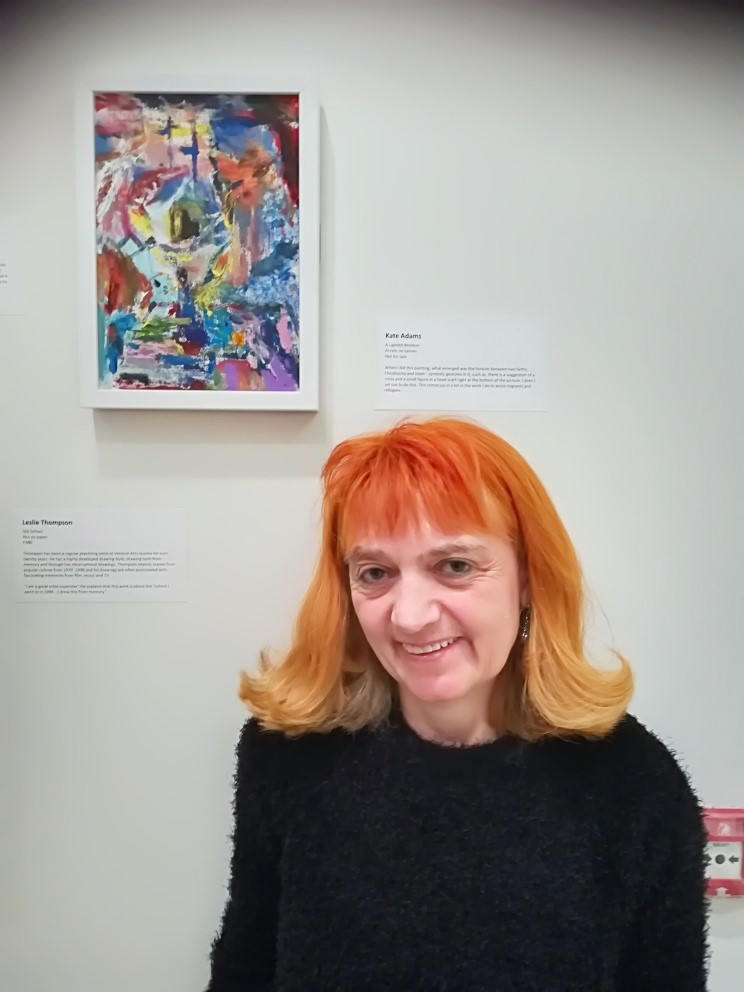
Kate Adams is an artist who obtained a BA in Fine Art in 1976.
Her painting, A Lighted Window was one of 80 artworks out of 900 selected to be displayed in the Environments Exhibition, Piano Nobile Gallery, London, organized by Outside In, November 2019. She works for Kent Refugee Help, a Whitstable-based charity assisting detained migrants who face deportation and has coordinated many events to raise awareness and help migrant artists progress their work. She dreams of a world where everyone can fulfill their potential and no one is excluded because of where they were born.
You can see more of Kate’s work here.
Outside In film
Whitstable Views: How You Can Help
- Make sure you share and like our articles on Facebook and Twitter, and whatever other social-media platforms you use.
- Follow the site to get regular updates about new articles when they appear. Press the “Follow” icon in the bottom right hand corner of your screen and that will take you to the option to sign up. (It disappears as you move the text down, then reappears as you move it back up again!)
- Leave comments on the site rather than on Facebook. Let’s get a debate going. All of our contributors are willing to engage with you if you leave a comment.
- To all writers out there, we would LOVE you to make a contribution. Read our submissions page for details on how to go about that: https://whitstableviews.com/submissions/
- Finally you can donate. As little as £1 would help. Details on the donations page here: https://whitstableviews.com/donate/
